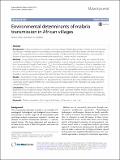| dc.contributor.author | Endo, Noriko | |
| dc.contributor.author | Eltahir, Elfatih A. B. | |
| dc.date.accessioned | 2016-12-08T22:54:58Z | |
| dc.date.available | 2016-12-08T22:54:58Z | |
| dc.date.issued | 2016-12 | |
| dc.date.submitted | 2016-09 | |
| dc.identifier.issn | 1475-2875 | |
| dc.identifier.uri | http://hdl.handle.net/1721.1/105762 | |
| dc.description.abstract | Background
Malaria transmission is complex, involving a range of hydroclimatological, biological, and environmental processes. The high degree of non-linearity in these processes makes it difficult to predict and intervene against malaria. This study seeks both to define a minimal number of malaria transmission determinants, and to provide a theoretical basis for sustainable environmental manipulation to prevent malaria transmission.
Methods
Using a field-tested mechanistic malaria model, HYDREMATS, a theoretical study was conducted under hypothetical conditions. Simulations were conducted with a range of hydroclimatological and environmental conditions: temperature (t), length of wet season (T[subscript wet]), storm inter-arrival time (T[subscript int]), persistence of vector breeding pools (T[subscript on]), and distribution of houses from breeding pools and from each other (X[subscript dist] and Y[subscript dist], respectively). Based on the theoretical study, a malaria time scale, T[subscript o], and a predictive theory of malaria transmission were introduced. The performance of the predictive theory was compared against the observational malaria transmission data in West Africa. Population density was used to estimate the scale that describes the spatial distribution of houses.
Results
The predictive theory shows a universality in malaria endemic conditions when plotted using two newly-introduced dimension-less parameters. The projected malaria transmission potential compared well with the observation data, and the apparent differences were discussed. The results illustrate the importance of spatial aspects in malaria transmission.
Conclusions
The predictive theory is useful in measuring malaria transmission potential, and it can also provide guidelines on how to plan the layout of human habitats in order to prevent endemic malaria. Malaria-resistant villages can be designed by locating houses further than critical distances away from breeding pools or by removing pools within a critical distance from houses; the critical distance is described in the context of local climatology and hydrology.
Keywords
Malaria transmission Hydrology Spatial impact Characteristic time scale | en_US |
| dc.description.sponsorship | National Science Foundation (U.S.) | en_US |
| dc.description.sponsorship | Masdar Institute of Science and Technology | en_US |
| dc.description.sponsorship | Massachusetts Institute of Technology | en_US |
| dc.publisher | BioMed Central | en_US |
| dc.relation.isversionof | http://dx.doi.org/10.1186/s12936-016-1633-7 | en_US |
| dc.rights | Creative Commons Attribution | en_US |
| dc.rights.uri | http://creativecommons.org/licenses/by/4.0/ | en_US |
| dc.source | BioMed Central | en_US |
| dc.title | Environmental determinants of malaria transmission in African villages | en_US |
| dc.type | Article | en_US |
| dc.identifier.citation | Endo, Noriko, and Elfatih A. B. Eltahir. “Environmental Determinants of Malaria Transmission in African Villages.” Malaria Journal 15.1 (2016): n. pag. | en_US |
| dc.contributor.department | Massachusetts Institute of Technology. Department of Civil and Environmental Engineering | en_US |
| dc.contributor.department | Parsons Laboratory for Environmental Science and Engineering (Massachusetts Institute of Technology) | en_US |
| dc.contributor.mitauthor | Endo, Noriko | |
| dc.contributor.mitauthor | Eltahir, Elfatih A. B. | |
| dc.relation.journal | Malaria Journal | en_US |
| dc.eprint.version | Final published version | en_US |
| dc.type.uri | http://purl.org/eprint/type/JournalArticle | en_US |
| eprint.status | http://purl.org/eprint/status/PeerReviewed | en_US |
| dc.date.updated | 2016-12-01T04:52:19Z | |
| dc.language.rfc3066 | en | |
| dc.rights.holder | The Author(s) | |
| dspace.orderedauthors | Endo, Noriko; Eltahir, Elfatih A. B. | en_US |
| dspace.embargo.terms | N | en_US |
| dc.identifier.orcid | https://orcid.org/0000-0003-4123-0489 | |
| mit.license | PUBLISHER_CC | en_US |
| mit.metadata.status | Complete | |
